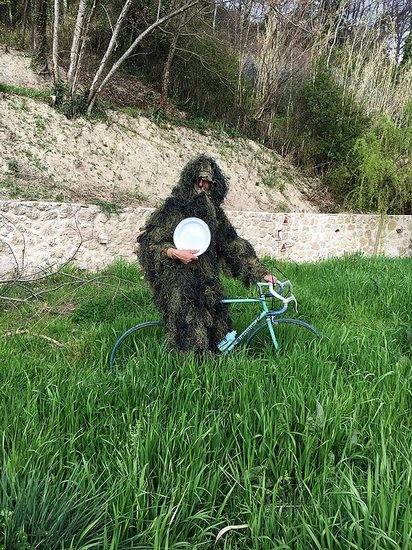Juergen Teller
20 Apr - 03 Jul 2017

Juergen Teller, Anne & Elisa No.1, Man About Town, Magazine Cover Spring/Summer 2016 © Juergen Teller
JUERGEN TELLER
Enjoy Your Life!
20 April - 3 July 2017
Juergen Teller, born in 1964 in southern Germany, is one of the world’s most sought-after contemporary photographers. His works, many of which take the form of extensive series, are published in books, magazines and exhibitions.
In 1986, Teller moved to London and began to work for trendy music, zeitgeist and fashion magazines. He came to fame in 1991 when he photographed the band Nirvana, and his pictures of Kurt Cobain were published. Since then his pictures have straddled the interface of art and commercial photography. His stylistic device of choice is the portrait. Working in the areas of music, fashion and celebrities as well as everyday scenes and landscape, he draws on his intuitive feel for people, situations, milieus and clichés to create images of great immediacy and deceptive simplicity.
«Everything in a wide sense is a kind of self-portrait. It‘s just the way you see things and you‘re curious about certain things and just excited about them.»
Juergen Teller
His compositions often convey a sense of the incidental or even slapdash, but on closer inspection it becomes clear that they are very carefully composed and conceptualised. Implicit in many of his works is the deliberate breach of viewer expectations – Teller does not idealise, romanticise or prettify. Instead, his pictures aim for the very core of the subject and foreground the idea of imperfect beauty.
Deliberately distancing himself from the relentless glamour of fashion and people photography, Juergen Teller forged his own distinctive path. In his shoots for well-known fashion designers, he not only placed supermodels, pop stars and other celebrities in unexpected and often disturbing contexts, he also allowed their individuality to shine through, thus lifting the images out of established visual codes and preconceived expectations. Teller applies the same artistic principle to his non-commercial work.
The resulting images – now more than ever – are baffling, unpredictable, cliché-defying, intimate, seemingly transgressive and in-your-face, but never compromising, because they are informed by great empathy and sensitivity. Juergen Teller demands a lot from his sitters. He expects them to let go of inhibitions and to embrace a raw and unvarnished authenticity, but he gives as good as he gets. He uses the set, the props, his camera and, above all, the sitters as a film director might and frequently acts as the protagonist of his own images, delegating the operation of the shutter release to someone else. In doing so, he integrates the viewer’s gaze into his visual conceptualisation and invites the audience to share in his playful game. His steady focus on the motif, candid and curious, open and unblinkered, calls for tolerance and curiosity on the part of the viewer.
Other groups of works are more autobiographical and occasionally anecdotal: quiet landscapes from Nürnberg, carefully staged yet unsparingly candid images of himself in The Clinic and subjective documentations of his engagement with his youth and his origins such as Irene im Wald.
Enjoy Your Life!
20 April - 3 July 2017
Juergen Teller, born in 1964 in southern Germany, is one of the world’s most sought-after contemporary photographers. His works, many of which take the form of extensive series, are published in books, magazines and exhibitions.
In 1986, Teller moved to London and began to work for trendy music, zeitgeist and fashion magazines. He came to fame in 1991 when he photographed the band Nirvana, and his pictures of Kurt Cobain were published. Since then his pictures have straddled the interface of art and commercial photography. His stylistic device of choice is the portrait. Working in the areas of music, fashion and celebrities as well as everyday scenes and landscape, he draws on his intuitive feel for people, situations, milieus and clichés to create images of great immediacy and deceptive simplicity.
«Everything in a wide sense is a kind of self-portrait. It‘s just the way you see things and you‘re curious about certain things and just excited about them.»
Juergen Teller
His compositions often convey a sense of the incidental or even slapdash, but on closer inspection it becomes clear that they are very carefully composed and conceptualised. Implicit in many of his works is the deliberate breach of viewer expectations – Teller does not idealise, romanticise or prettify. Instead, his pictures aim for the very core of the subject and foreground the idea of imperfect beauty.
Deliberately distancing himself from the relentless glamour of fashion and people photography, Juergen Teller forged his own distinctive path. In his shoots for well-known fashion designers, he not only placed supermodels, pop stars and other celebrities in unexpected and often disturbing contexts, he also allowed their individuality to shine through, thus lifting the images out of established visual codes and preconceived expectations. Teller applies the same artistic principle to his non-commercial work.
The resulting images – now more than ever – are baffling, unpredictable, cliché-defying, intimate, seemingly transgressive and in-your-face, but never compromising, because they are informed by great empathy and sensitivity. Juergen Teller demands a lot from his sitters. He expects them to let go of inhibitions and to embrace a raw and unvarnished authenticity, but he gives as good as he gets. He uses the set, the props, his camera and, above all, the sitters as a film director might and frequently acts as the protagonist of his own images, delegating the operation of the shutter release to someone else. In doing so, he integrates the viewer’s gaze into his visual conceptualisation and invites the audience to share in his playful game. His steady focus on the motif, candid and curious, open and unblinkered, calls for tolerance and curiosity on the part of the viewer.
Other groups of works are more autobiographical and occasionally anecdotal: quiet landscapes from Nürnberg, carefully staged yet unsparingly candid images of himself in The Clinic and subjective documentations of his engagement with his youth and his origins such as Irene im Wald.


